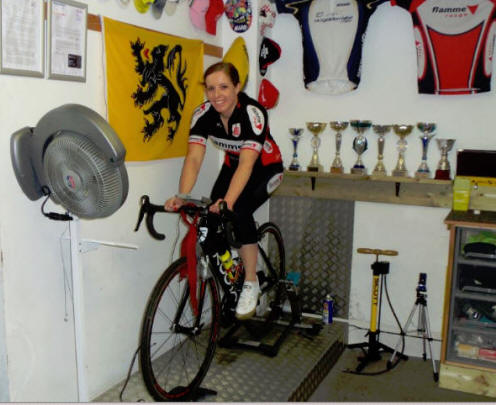FAQ ~ Self Testing

Kat Guillemot ~ smiling (this is still the warm up)
There are many benchmarks against which you can test yourself, some more appropriate than others. It all depends on what it is you're measuring and why.
We have a selection of "tests" we can carry out on riders, but for most of the world, a trip to our delightful island isn't always an option. So what do you do if you're in need of a general purpose fitness "reality check"?
The best "home option" is to carry out a 20 minute TT on a turbo. You remove all the variables; no headwind, no traffic, no distractions, no worrying about being seen, no grief. Just get on the bike and ride it.
Performance Test Setup
We all call them tests, but they are not. They're performance
evaluations. All we are doing is checking our current position
in the big scheme of things. We don't pass, we don't fail,
we're not being judgemental. We're just getting a baseline of
where we now are.
So set the bike in the turbo. Check and write down all the things you need to check, to replicate it for future use...
Tyre Pressure (back!) ~ say 100 psi
Roller Resistance ~ how many turns
Turbo slope, resistance, setting
Time of day
You may use some, or none, of the above, they are just there to assist with a possible list of things of import.
But you need to minimise as much variance as you can to ensure that you are always comparing like for like. It's surprising how much five psi can have on a turbo and the differences between a morning and evening run can be huge! So always use your list.
The Test...
After a good and thorough warm up,
remember the warm up is to oxygenate the blood, not just to get you
hot! You can start your 20 minute effort.

A 20 minute "test" exploring the limits of fitness
Ease yourself in to the effort and feel the edge of your comfort zone. Don't race the test, and don't try to set a PB in the first two minutes and hope to hang on for the following eighteen. It ain't gonna happen!
And under no circumstances whatsoever, try to ride to a heart rate!
For me, all my tests, and all those I carry out for athletes, are ridden blind. All the readouts, screens and parameters are covered. All you need to know is how much time is left.
Your only objective is to get to the end with nothing left. If you feel you could of done 21 minutes, you never went hard enough. If you crash and burn at 19, you went too hard. Although you should always strive get to the end of the 20 minutes, at any speed, because the number will be what it will be. It's a reflection of your current fitness.
Whatever it is, you now have a benchmark, against which you can plot all future progress. But what is it? What did you measure?
Tracking Progress
In terms of measuring stuff, it depends on the type of turbo you
have and how it reacts to increasing speeds. Some (most fluid)
turbo's increase the resistance as speed increases. So the
faster you go, the harder it gets. So obviously these are
likely to compromise your testing results.
The best ones are electronic, magnetic, or programmable turbo's and strangely, the cheaper the turbo, the better it is for testing purposes.
In order of "bestness", the parameters that we want to measure are power, distance, average speed.
Power is the "gold standard" but it's not the be all and end all. If you don't have power no problem. A watt, is a watt. So the more watts you have the better.
As is a kilometre! If, in 20 minutes, you rode more kilometres this time than last time, then it has to be better. As it does for average speed. But if you can measure speed, you can calculate distance.
Forty kph, for 20 minutes, equals (40 divide by 3 (20 minutes is a third of an hour)) 13.333 kilometres.
Although we can see we are 20 watts stronger then last time, what does that really mean. Can you envisage that? Because I can't!
But if you can see you went 250 metres further "up the road" than you did last time, then now we have a picture in our head of how well we've done.
It really is as simple as that.
This is a 30 second video of a six minute wVO2max test. You shouldn't be suffering this much in a 20 minute FTP test!
Power Results...?
If you have access to power readings for your test, you can estimate
your current Functional
Threshold Power from the results. Take your average 20
minute power and multiply it by 0.95, to give you your current FTP
power output.








